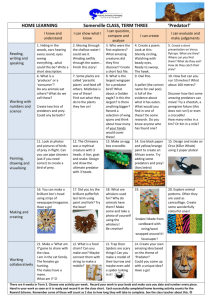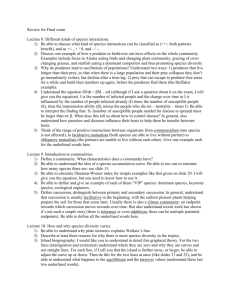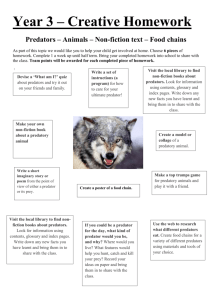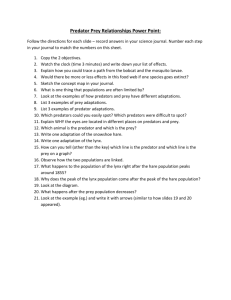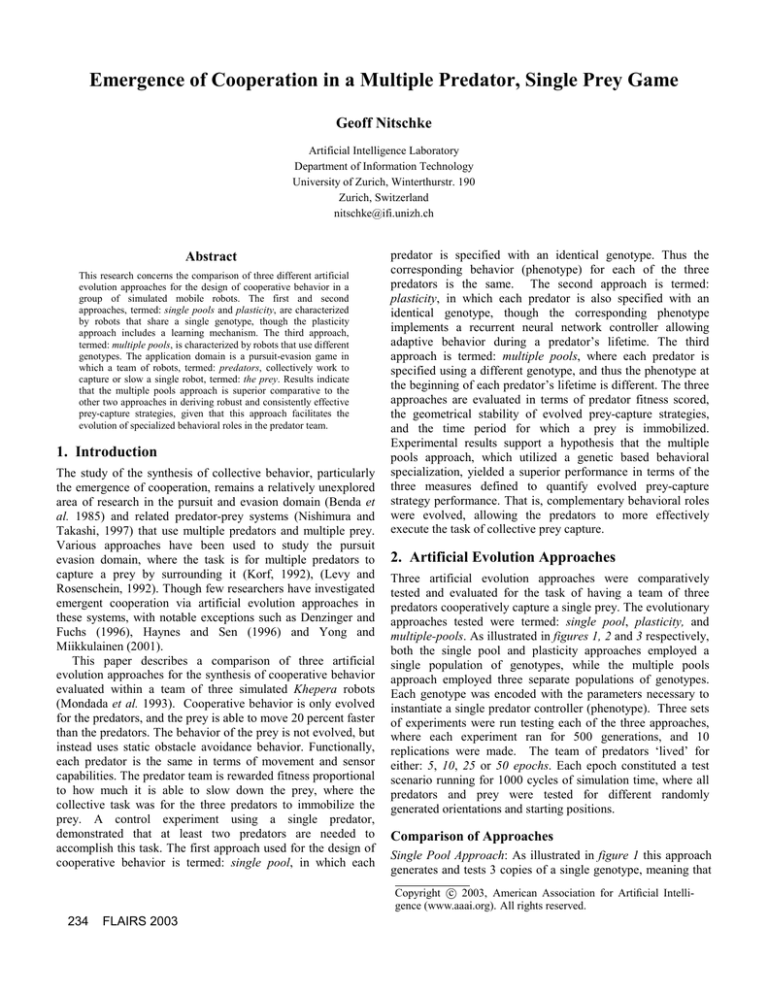
Emergence of Cooperation in a Multiple Predator, Single Prey Game
Geoff Nitschke
Artificial Intelligence Laboratory
Department of Information Technology
University of Zurich, Winterthurstr. 190
Zurich, Switzerland
nitschke@ifi.unizh.ch
Abstract
This research concerns the comparison of three different artificial
evolution approaches for the design of cooperative behavior in a
group of simulated mobile robots. The first and second
approaches, termed: single pools and plasticity, are characterized
by robots that share a single genotype, though the plasticity
approach includes a learning mechanism. The third approach,
termed: multiple pools, is characterized by robots that use different
genotypes. The application domain is a pursuit-evasion game in
which a team of robots, termed: predators, collectively work to
capture or slow a single robot, termed: the prey. Results indicate
that the multiple pools approach is superior comparative to the
other two approaches in deriving robust and consistently effective
prey-capture strategies, given that this approach facilitates the
evolution of specialized behavioral roles in the predator team.
1. Introduction
The study of the synthesis of collective behavior, particularly
the emergence of cooperation, remains a relatively unexplored
area of research in the pursuit and evasion domain (Benda et
al. 1985) and related predator-prey systems (Nishimura and
Takashi, 1997) that use multiple predators and multiple prey.
Various approaches have been used to study the pursuit
evasion domain, where the task is for multiple predators to
capture a prey by surrounding it (Korf, 1992), (Levy and
Rosenschein, 1992). Though few researchers have investigated
emergent cooperation via artificial evolution approaches in
these systems, with notable exceptions such as Denzinger and
Fuchs (1996), Haynes and Sen (1996) and Yong and
Miikkulainen (2001).
This paper describes a comparison of three artificial
evolution approaches for the synthesis of cooperative behavior
evaluated within a team of three simulated Khepera robots
(Mondada et al. 1993). Cooperative behavior is only evolved
for the predators, and the prey is able to move 20 percent faster
than the predators. The behavior of the prey is not evolved, but
instead uses static obstacle avoidance behavior. Functionally,
each predator is the same in terms of movement and sensor
capabilities. The predator team is rewarded fitness proportional
to how much it is able to slow down the prey, where the
collective task was for the three predators to immobilize the
prey. A control experiment using a single predator,
demonstrated that at least two predators are needed to
accomplish this task. The first approach used for the design of
cooperative behavior is termed: single pool, in which each
predator is specified with an identical genotype. Thus the
corresponding behavior (phenotype) for each of the three
predators is the same. The second approach is termed:
plasticity, in which each predator is also specified with an
identical genotype, though the corresponding phenotype
implements a recurrent neural network controller allowing
adaptive behavior during a predator’s lifetime. The third
approach is termed: multiple pools, where each predator is
specified using a different genotype, and thus the phenotype at
the beginning of each predator’s lifetime is different. The three
approaches are evaluated in terms of predator fitness scored,
the geometrical stability of evolved prey-capture strategies,
and the time period for which a prey is immobilized.
Experimental results support a hypothesis that the multiple
pools approach, which utilized a genetic based behavioral
specialization, yielded a superior performance in terms of the
three measures defined to quantify evolved prey-capture
strategy performance. That is, complementary behavioral roles
were evolved, allowing the predators to more effectively
execute the task of collective prey capture.
2. Artificial Evolution Approaches
Three artificial evolution approaches were comparatively
tested and evaluated for the task of having a team of three
predators cooperatively capture a single prey. The evolutionary
approaches tested were termed: single pool, plasticity, and
multiple-pools. As illustrated in figures 1, 2 and 3 respectively,
both the single pool and plasticity approaches employed a
single population of genotypes, while the multiple pools
approach employed three separate populations of genotypes.
Each genotype was encoded with the parameters necessary to
instantiate a single predator controller (phenotype). Three sets
of experiments were run testing each of the three approaches,
where each experiment ran for 500 generations, and 10
replications were made. The team of predators ‘lived’ for
either: 5, 10, 25 or 50 epochs. Each epoch constituted a test
scenario running for 1000 cycles of simulation time, where all
predators and prey were tested for different randomly
generated orientations and starting positions.
Comparison of Approaches
Single Pool Approach: As illustrated in figure 1 this approach
generates and tests 3 copies of a single genotype, meaning that
c 2003, American Association for Artificial IntelliCopyright °
gence (www.aaai.org). All rights reserved.
234
FLAIRS 2003
the predator team is homogenous. In this approach there is no
plasticity so the predators cannot adapt during their lifetime.
The fitness assigned to each predator is the simply the fitness
calculated for the single genotype that specifies the predator
team. The main advantage of this approach is its simplicity in
terms of behavioral encoding and calculation of team fitness.
Figure 1. Single Pool – Each predator phenotype corresponds to a
genotype selected from a population and copied 3 times.
Plasticity Approach: As illustrated in figure 2 this approach
generates and tests three copies of a single genotype, so that as
with the single pool approach, the predator team is
homogenous. The difference is that individual phenotypes are
able to adapt during their lifetime as a result of a recurrent
neural network learning process. The advantage of the
plasticity approach is that it allows for specialization of
behavior by individual predators without being affected by the
problem of needing to estimate fitness contribution of different
predators to the team as a whole. For both the single pool and
plasticity approaches, every individual genotype in the
population is tested against two randomly selected genotypes
from the same population. This process is repeated for all
epochs of a predator’s lifetime.
Figure 2. Plasticity. Same as Single Pool, though phenotypes
implement a recurrent neural network controller.
Multiple Pools Approach: As illustrated in figure 3 this
approach takes a single genotype from each of the three
populations of genotypes. Each genotype is then decoded into
a separate phenotype, where this set of three phenotypes then
comes to represent the team of predators. In each generation,
every individual genotype in a population is tested against two
other genotypes, randomly selected from one of the other
populations of genotypes. This process is then repeated for all
epochs of a predator’s lifetime. The advantage of the multiple
pools approach is that it encourages behavioral specialization in
the group of predators, in that the artificial evolution setup
provides for more genetic diversity in the three predator
genotypes.
Figure 3. Multiple Pools. Predator phenotypes correspond to 3
different genotypes selected from 3 separate pools of genotypes.
2.2 Evaluation of Approaches
For both the single pool and plasticity approaches a single
genotype specifies the entire predator team. That is, predators
are clones of each other, so evaluation of team performance
in this case is not problematic. The performance of a predator
team executed under either of these approaches is simply
measured as the fitness value assigned to the genotype that
specifies the team. In contrast to these approaches a predator
team using the multiple pools approach is specified by three
genotypes selected from three different populations.
A method of evaluation widely known as: fitness sharing
(Bull and Holland, 1997) was implemented for the multiple
pools approach, where an equal fitness score is assigned to
each individual genotype, thereby assuming that each
individual contributed to team performance equally. The
advantage of this method is that fitness for individual
genotypes is easily calculated and there is no disparity between
team fitness and the fitness of individual team members.
2.3 Agents, Environment and Artificial Evolution
For all experiments a generational evolutionary algorithm
using linear rank-based selection was used (Goldberg, 1989).
Each population contained 100 genotypes, where initial
populations consisted of randomly generated genotypes.
Genotype length was set to 24 genes, where each gene
consisted of several bits encoding each neuron type and
connection weights. At the turn of each generation, the 20
genotypes that have accumulated the highest fitness were
allowed to reproduce. The total fitness of an individual
genotype was the sum of all its fitness for all epochs of its
life. Reproduction was done via generating five copies of
each genotype in order to create the next generation. During
this copying process 10 percent of the connection weights
were mutated. Mutation added a random value between –1.0
and +1.0 to the weights current value. This process was
repeated for the 500 generations that each experiment was
executed for.
The body of each predator and prey is a simulation of a
Khepera mobile robot (Mondada et al. 1993). The robots used
as predators were equipped with 8 infrared proximity sensors,
and 8 light sensors positioned on the circular periphery of the
robot. The robots used as prey were equipped with 8 infrared
proximity sensors, as well as a light on its top. This light
could be detected by the predator light sensors and was used
so as each predator robot could distinguish fellow predators
from the prey. A recurrent neural network consisting of input
and output layers with no hidden units (Nolfi and Parisi,
1997) controlled all robots. In the case of the predators, the
input layer consisted of 16 units that encoded the activation
level of the robots 16 sensors. These 16 input units were
connected to 4 output units. In the plasticity experiments, the
activation level of two additional output units was copied
back into two additional input units. The first two output units
represented the two motors of the robot and encoded the
speed of the two wheels. These motor units controlled the
FLAIRS 2003
235
robots behavior in the environment. The next two output units
represented two teaching units that encoded a teaching input
for the first two output units. The two motor units used this
teaching input in order to learn using the back propagation
procedure (Rumelhart et al. 1986). In the plasticity
experiments there were an additional two output units that
were the recurrent units and contained activation values for
the motors from the previous cycle. For the robots that were
the prey, a network connecting 8 sensory input units to 4
motor output units was trained for an obstacle avoidance
behavior before being placed in the environment. The
environment corresponded to a 1000cm x 1000cm arena with
no obstacles. When a predator robot was placed in the
environment, sensory input was received via the input units,
and activation values were passed to the two motor units, and
the teaching units. The activation value of the two motor units
was used to move the robot, thus changing the sensor input
for the next simulation cycle. The activation value of the two
teaching units was used to change the weights that connected
the input units to the motor units using back propagation.
3.1 Evolved Behavior
Single Pool: Three emergent cooperative strategies were
consistently observed. These were termed: encirclement,
entrapment and knocker and are illustrated in figures 7, 8 and 6
respectively. The three-predator entrapment strategy emerged
in 60 percent of replications, while the three-predator
encirclement strategy emerged in 40 percent of replications.
The most frequently observed was the two-predator knocker
strategy, which emerged in 80 percent of replications.
Figure 5. Average Group Stability Index for epoch settings tested
under the Single Pool, Plasticity, and Multiple Pools approaches.
2.4 Evaluation of Cooperative Behavior
In order to quantify the effectiveness of emergent prey
capture strategies, three different measures were used to
evaluate performance. The first was predator team fitness,
where fitness awarded to the team was proportional to how
much a prey was slowed during the team’s lifetime. The
second was prey capture time, which was the time period for
which a prey was immobilized by the collective efforts of at
least two predators, and the third measure was a statistical
index termed: group stability index. Adapted from
Baldassarre et al. (2002), this index measured how stable a
particular geometric formation of a group of predators was
with respect to the prey for a given time period. For example,
if the predators form a circle about the position of the prey,
the index will indicate for how long the predators maintain
this circle formation. If the predators are able to hold a certain
formation for an extended period of time, the index will be
high indicating high group stability.
3. Results
Figure 6. Average Prey-Capture Time for epoch settings tested under
the Single Pools, Plasticity, and Multiple Pools approaches.
Figure 7 illustrates the encirclement strategy, where three
predators move to circle the prey, each moving in the same
direction in close proximity to the prey, for some period of
time. The strategy slowed the prey significantly and scored a
high fitness, though was only effective for a short period of
time, as the predators were not able to coordinate their
movements for an extended period or able to immobilize the
prey. This strategy was also observed using two predators,
though prey capture time was longer.
Figures 4, 5, and 6 illustrate the average fitness, group
stability, and prey-capture time, for single pool, plasticity and
multiple pools approaches.
Figure 7. A cooperative strategy, termed encirclement, observed in
the single pool experiments.
Figure 4. Average fitness for epoch settings tested under the single
pool, plasticity, and multiple pools approaches.
236
FLAIRS 2003
Figure 8 depicts an example of the entrapment strategy,
using three predators, where a predator moves to each side of
the prey (predator 1 and 2), while a third (predator 3) moves
around one of the flanking predators to approach the prey from
the front, in order to halt the prey in a triangular formation.
When the prey turns to escape, the two flanking predators
move also, turning to force the prey in a specific direction. The
third predator (predator 2 now) then moves about also in order
to affront the prey. This system of entrapment, movement, and
then entrapment continues several times before the prey is able
to evade the predators.
Figure 8. A cooperative strategy, termed entrapment, observed in the
single pool experiments.
Figure 9 depicts an example of the knocker strategy, where
two predators move so as to flank either side of the prey. One
predator places itself on the right side of the prey moving in
front and forcing the prey to spiral inwards, while the predator
to the left moves with the prey also, knocking into the side of
the prey forcing it to slow more than usual.
Figure 9. A cooperative strategy, termed knocker, observed in the
single pool and plasticity experiments.
Plasticity: In these experiments three cooperative prey
capture strategies emerged. These included the two-predator
strategy: knocker, as well as a derivative of the previously
described entrapment strategy. This new derivative strategy,
termed: role switcher, illustrated in figure 10 proved superior
comparative to other emergent strategies in terms of preycapture time. Figure 10 highlights the predators using a form
of behavioral specialization so that a third predator moves
along side another of the predators and role of the flanker
switches between the two predators whenever the prey tries to
evade the predators. The knocker strategy emerged most
frequently, observed in 80 percent of replications, and the role
switcher strategy emerged in 50 percent of replications.
Figure 10. Role Switcher. Predator 3 moves aside flanking predator 2,
and the flanking role switches when the prey attempts evasion.
Multiple Pools: In these experiments a derivative of the
knocker strategy was the only cooperative strategy that
frequently emerged, observed in 90 percent of replications. In
this derivative version, a particular predator always assumed
the flanking role, while the other predators assumed the role
either the knocker or that of an idle third predator.
4. Analysis and Discussion
In this section the three artificial evolution approaches are
discussed in relation in relation to the three performance
measures defined for cooperative prey capture.
Single Pool: These experiments yielded prey-capture
strategies using two and three predators. The knocker strategy,
illustrated in figure 9, was an emergent prey-capture strategy
using two predators, and the encirclement and entrapment
strategies, illustrated in figures 7 and 8, were emergent preycapture strategies using three predators. Comparative to the
three-predator strategies, the two-predator knocker strategy
proved superior in terms of measures for prey capture time and
group stability. Low group stability and prey-capture time of
the encirclement and entrapment strategies was found to be a
result of physical interference between the three predators as
they collectively approached the prey. The chance of
interference was reduced with the simpler knocker strategy,
which thus had the advantage of being dominant in the
population of individuals, and selected for in the evolutionary
process. This is reflected in figures 4, 5 and 6, which illustrate
a higher average fitness, group stability and prey-capture time
for experiments testing 25 and 50 epochs. The use of more
epochs provides more tests for each individual genotype thus
increasing the likelihood that only robust strategies will be
propagated. Also, note in figure 4, comparing experiments
using 5 epochs and 25 epochs under the single pool approach,
a similarly high fitness was attained. This was due to the
encirclement and entrapment strategies emerging with
frequency comparable to the knocker strategy, so a high
average fitness was scored. Experiments using the single pool
approach indicated that evolution had selected for and
propagated a simpler and more robust strategy using only two
predators that was consistently effective due to minimal
interference between these two predators.
Plasticity: Experiments executed under the plasticity
approach yielded the knocker strategy as well as the threepredator role-switcher strategy. In role switcher the predators
developed a dynamic form of behavioral specialization,
meaning that each assumed a role based upon its current
position and orientation relative to the prey at a given point in
time. Figure 10 illustrates the predators switching roles during
the course of the role-switcher strategy, so that flanking
predators switched roles whenever the prey turned to escape.
This dynamic role assumption served to make the roleswitcher strategy more effective, comparative to the single
pools approach, in terms of the defined performance measures.
This is reflected in figure 4, which illustrates a progressively
higher yet similar average fitness, comparative to the single
pool approach, for 10, 25 and 50 epochs. Specifically, physical
interference between predators was reduced as they
collectively approached the prey, given that they assumed
specific, though not always complementary behavioral roles.
FLAIRS 2003
237
In the single pool approach, such interference often caused the
entrapment and encirclement strategies to fail prematurely
thereby making their selection and propagation by the
evolutionary process more unlikely.
Multiple Pools: In these experiments the emergence of only
one strategy was observed, which was a variation of the roleswitcher strategy that emerged in the plasticity experiments.
Though, where as the plasticity version of role-switcher used a
dynamic form of role assumption, the multiple pools version
used predators evolved for a specific role. That is, for all
epochs tested in these experiments, each of the three predators
evolved a specific behavioral role that allowed the team to
collectively overcome the physical interference that
confounded the teams tested in the single pool and plasticity
approaches. In the plasticity experiments the adoption of
specialized roles was dependent upon the positions of the
predators at a given time. This dynamic form of role
assumption still proved problematic in situations where all
three predators were in close proximity to the prey when
approaching it, as two or more predators typically attempted to
assume the same behavioral role, thus causing physical
interference, the role-switcher strategy to fail, and allowing the
prey to escape. Where as, in the multiple-pools version of role
switcher strategy, different predators evolved so as to assume a
specific role during their lifetime so each initially behaved
differently. That is, one predator always assumed the role of a
flanker, one the role of a knocker and another the role of an
idle predator, where these behavioral roles complemented each
other in formation of the strategy. The effectiveness this
strategy in the multiple pools approach, is evident from the
higher fitness, group stability and prey-capture time.
5. Conclusions
This paper presented a set of experiments testing three
different artificial evolution approaches for the synthesis of
cooperative behaviour in a team of simulated mobile robots,
operating within a pursuit-evasion domain. The team of robots,
termed predators, was given the task of collectively capturing a
single robot termed the prey. The performance of emergent
prey capture strategies was quantified in terms of group
stability, prey-capture time, and predator fitness.
Results presented indicated the multiple pools approach to
be superior in terms of these three measures. In the multiple
pools approach only one cooperative prey-capture strategy,
which was a variation of the plasticity role-switcher strategy,
consistently emerged. The superiority of the multiple pools
approach was found to be a result of a genetic based behavioral
specialization in the multiple pools role-switcher. That is, in
the multiple pools role-switcher, specific roles were
consistently assumed by the different predators. This improved
the effectiveness of multiple pools knocker strategy compared
to the single pool and plasticity approaches, in that it reduced
interference between predators as they collectively approached
the prey. This is especially evident from a comparison with the
238
FLAIRS 2003
single pool experiments, where three-predator strategies with
no behavioral specialization emerged and performed less well.
Finally, experimental results highlighted that artificial
evolution is an effective method for deriving cooperative prey
capture strategies using predator teams with no explicit
communication, or coordination mechanisms.
References
Baldassarre, G., Nolfi, S., and Parisi, D. 2002. Evolving Mobile
Robots Able to Display Collective Behaviors. In Proceedings of the
International Workshop on Self-Organization and Evolution of
Social Behaviour, pages 11--22. Monte Verità, Switzerland. Addison
Wesley.
Benda, M., Jagannanthan, V., and Dodhiawalla, R. 1985. An
Optimal Cooperation of Knowledge Sources. Technical BCSG2010-28, Boeing AI Center.
Bull, L., and Holland, O. 1997. Evolutionary Computing in MultiAgent Environments: Eusociality. In Proceedings of the Second
Annual Conference on Genetic Programming, pages 347--352. San
Francisco, U.S.A. Morgan Kaufmann.
Denzinger, J., and Fuchs, M. 1996. Experiments in Learning
Prototypical Situations for Variants of the Pursuit Game. In
Proceedings of the Second ICMAS conference, pages 48--55, Kyoto,
Japan.
Goldberg, D. Genetic Algorithms.
York, USA.
1989. Addison Wesley, New
Haynes, T., and Sen, S. 1996. Evolving behavioral strategies in
predators and prey. Adaptation and Learning in Multi-Agent
Systems, Springer-Verlag, Berlin.
Korf, R. E. A simple solution to pursuit games. 1992. Working
Papers of the Eleventh International Workshop on DAI, pages 195-213. Geneva, Switzerland.
Levy, R., and Rosenschein, J. S. A Game Theoretic Approach to
Distributed Artificial Intelligence and the Pursuit Problem. 1992. In
Decentralized AI III, pages 129--146, Kaiserslautern, Germany.
Springer-Verlag, Berlin.
Mondada, F., Franzi, E., and Ienne, P. 1993. Mobile Robot
Miniaturization: A tool for Investigation in Control Algorithms. In
Proceedings of Third International Symposium on Experimental
Robotics, pages 501--513, Kyoto, Japan. Springer-Verlag, Berlin.
Nishimura, S. I., and Ikegami, T. 1997. Emergence of Collective
Strategies in a Prey-Predator Game Model. Artificial Life, 3(1):
243--260. MIT Press, Cambridge, USA.
Nolfi S. and Parisi D. 1997. Learning to adapt to changing
environments in evolving neural networks. Adaptive Behavior, 5(1):
75--98. MIT Press, Cambridge, USA.
Rumelhart, D. E., Hinton, G. E., and Williams, R. J. 1986.
Learning internal representations by error propagation. Parallel
Distributed Processing, Volume 1: Foundations. MIT Press,
Cambridge, USA.
Yong, C. H., and Miikkulainen, R. 2001. Cooperative Co-evolution
of Multi-Agent Systems. Technical Report AI01-287. Department of
Computer Science, University of Texas, USA.

